| Feb-22-07 | | Ybrevo: Yet another wild draw involving Aronian in this tournament! This time though, he wasn´t on the edge of loosing. I haven´t had time to analyse the final position. Does Leko have a "fortress", or should Black have played on? We´ll see... |
|
| Feb-22-07 | | euripides: I posted this last night on the tournament page but it really belongs here: I think, from the final position, Aronian would have won if all the king's side pawns had come off, by e.g. putting his king on c5 and his rook on b4/a5 and taking on b5. After Bxb5 Kxb5 if White's king is on a3 he can play b4 a5 bxa5 Kxa5 and Black wins; otherwise Black brings the king to b4 and plays a4 winning. However, I assume Aronian couldn't see any way to get the king's side pawns off. |
|
| Feb-22-07 | | percyblakeney: From Mig's blog:
<we spoke on the air with Aronian after the game and he said he simply thought the B vs R endgame was winning for him. Otherwise, he said, he would have hung on to his f-pawn. Leko's knowledge of practical theoretical endgames has few equals in the chess world, it's worth noting. I asked Aronian about his lucky escape against Moro in round three, specifically if he had seen the spectacular mate Morozevich missed. He said "no, of course not, or as a gentleman I would have resigned immediately!" I called him a liar and he cracked up. Nice try, Levon! He's hilarious> http://www.chessninja.com/dailydirt... |
|
| Oct-30-11 | | Hesam7: Leko had a chance to gain advantage with: 20. Rb7! Qxb5 21. Nxf7 Rd7 22. Rxd7 Qxd7 23. Ne5 Qc7 (23. ... Bxe5 24. dxe5 and the knight has to go to e8) 24. Bh3 Re8 25. Qa4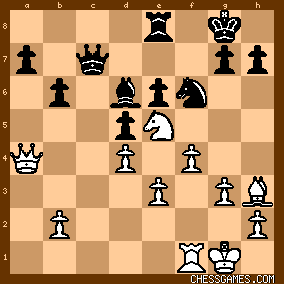
click for larger viewBlack's weaknesses (a7, e6 and c6) are tough to defend. |
|
Oct-30-11
 | | beatgiant: <Hesam7>
Does Black really need to allow Nxf7? What if 20. Rb7 Rf8? |
|
| Oct-31-11 | | Hesam7: <beatgiant: <Hesam7> Does Black really need to allow Nxf7? What if 20. Rb7 Rf8?> 20. Rb7! Rf8?! 21. Qe2 Qb3 22. Bh3! (22. Ra1?! Rfc8 intending ... Rc2 equalizes and explains 21. ... Qb3) 22. ... Bxe5 (only way of defending against Nxf7 & Bxe6) 23. fxe5 Ne4 (23. ... Ne8? 24. Rfxf7 Rxf7 25. Bxe6  ) 24. Rc7! Ng5 25. Bg2 Rac8 26. Rc6! (26. Rxa7? Rc2! ) 24. Rc7! Ng5 25. Bg2 Rac8 26. Rc6! (26. Rxa7? Rc2!  ) 26. ... a5! (eliminating the a7-weakness) 27. Rfc1 Rb8 28. Rc7 ) 26. ... a5! (eliminating the a7-weakness) 27. Rfc1 Rb8 28. Rc7 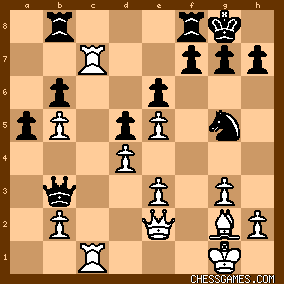
click for larger viewIt is a long line but several of Black's moves are forced. From the diagram White should win if he has good technique and Leko had no shortcomings in that department. |
|
Oct-31-11
 | | beatgiant: <Hesam7>
It's interesting. I underestimated the strength of the <Nxf7 & Bxe6> attack. For example, if 20. Rb7 Rf8 21. Qe2 Qb3 22. Bh3 Ne4, then <23. Nxf7 Rxf7 24. Bxe6 Rf8 25. Ra1> breaks through.So how about 20. Rb7 Rf8 21. Qe2 <Qa4> (guarding the a-file) 22. Bh3 g6. Is <Nxf7 & Bxe6> really so strong in that case? It leads to a rook and two pawns versus two minor pieces, a slight material advantage for White, but I don't see much immediate scope for making use of it. |
|
| Nov-01-11 | | Hesam7: <beatgiant: So how about 20. Rb7 Rf8 21. Qe2 <Qa4> (guarding the a-file) 22. Bh3 g6. Is <Nxf7 & Bxe6> really so strong in that case? It leads to a rook and two pawns versus two minor pieces, a slight material advantage for White, but I don't see much immediate scope for making use of it.> After <20. Rb7! Rf8?! 21. Qe2 Qa4 22. Bh3 g6 23. Nxf7 Rxf7 24. Bxe6 Rf8> White is not obliged to take on f7 right away, instead he should opt for: <25. b3!!> 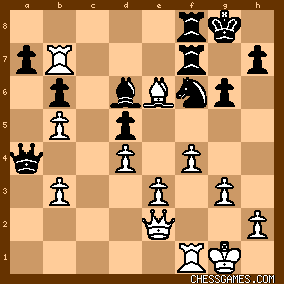
click for larger view<25. ... Qb4>
Any other Queen move will be met by e4!:
1) 25. ... Qa5(3) 26. e4 dxe4 27. Rxf7 Rxf7 28. Qc4  2) 25. ... Qxb3 26. e4! Black does not even have ... dxe4 so he has to play: 26. ... Qc4 (26. ... Nxe4? 27. Qxe4!) 27. Qxc4 dxc4 28. e5 Ne8 29. Bxc4 Kg7 30. Bxf7 Rxf7 31. Rxf7+ Kxf7 32. exd6 Nxd6 and now according to Critter instead of defending b5 with the rook 33. d5! wins by force: 33. ... Nxb5 34. Re1 Nd6 35. Rc1 Nb5 36. Kf2 Ke7 37. Ke3 Kd7 38. Rc6 Nd6 (denying e4) 39. Kd4 Nf7 (denying e5) 40. g4! and Black can resign. Essentially 25. b3!! is an overloading tactic, on a4 the Black Queen was preventing Ra1 and e4. After this move he has to choose the lesser of the evils White can not play 26. e4?? b/c of 26. ... Qxd4+ but now he gets the a-file: <27. Ra1 Kg7 28. Bxf7 Rxf7 29. Raxa7 Re7 30. Rxe7 Bxe7 31. Rb7 Qd6 32. g4> 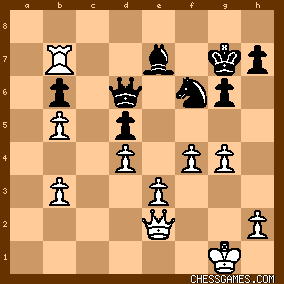
click for larger viewThis is not won by force but again any White player with a bit of technique, let alone Leko, should win this. |
|
Nov-03-11
 | | beatgiant: <Hesam7>
Thanks for that brilliant analysis. Yes, 20. Rb7 Rf8 is busted.But, Black can try 20. Rb7 <Bxe5> 21. fxe5 Rd7. After that, White has some attacking moves on the kingside, but I don't see how to convert it into a lasting initiative. |
|
| Nov-07-11 | | Hesam7: <beatgiant: But, Black can try 20. Rb7 <Bxe5> 21. fxe5 Rd7. After that, White has some attacking moves on the kingside, but I don't see how to convert it into a lasting initiative.> That actually might be the best defence for Black. <20. Rb7 Bxe5 21. fxe5 Rd7 22. Rxd7 Nxd7 23. Qc2> 23. Qe2? Rc8!= <23. ... Qxb5> forced. White has a choice here: [A] <24. Qc7 Rf8> forced <25. Rf2> defending b2 and vacating f1 <25. ... Nb8 26. Qxa7 Nc6 27. Qa3!> better than: 27. Qc7?! Na5. 
click for larger viewf7 is weak and the Black Queen and Knight are awkwardly placed however with few pieces left on the board the weakness of f7 is insignificant and the coordination problem is temporary. So White has the initiative but how long will it last? Black has a number of playable moves: 27. ... Nb4, 27. ... Na5, 27. ... Qa5, 27. ... Qb4 and 27. ... Qc4. [B] <24. e4 Qc4 25. Qf2 Rf8 26. exd5 f6 27. dxe6 Qxe6 28. exf6> 28. Qf5? Qxf5 29. Bd5+ Kh8 30. Rxf5 fxe5 31. Rxf8+ Nxf8 32. dxe5 Ng6 33. e6 Ne7  <28. ... Nxf6 29. d5 Qd6 30. Qd4 a5> preventing b4. <31. Rc1 Rd8> <28. ... Nxf6 29. d5 Qd6 30. Qd4 a5> preventing b4. <31. Rc1 Rd8> 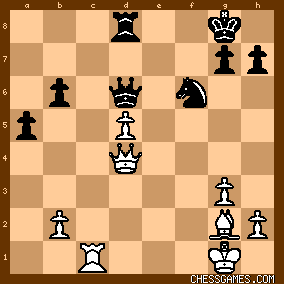
click for larger viewWhite has a nominal advantage but Black should hold. |
|





































